What is Internal Communication? What You Need to Know
Imagine how much faster you could complete projects if you always received an instant response to any question you asked a team member. Better yet, imagine if you didn't even have to ask them the question because you already knew the answer.
End-of-week projects could become end-of-day projects, and you could accomplish significantly more in a month.
This is why internal communication is critical.
So to help you achieve seamless internal communication, this post will discuss:
- What is internal communication?
- What are the benefits of strong internal communication?
- What are internal communication channels?
- What are the types of internal communication?
- What is an effective internal communication strategy?
- What are the best internal communication tools?
What is Internal Communication?
Internal communication, also referred to as internal comms, is how employees share information in the workplace.
Internal communication can happen in person, digitally (via Slack, email, etc.), or on paper.
What Are the Benefits of an Internal Communication Strategy?
In an ideal world, flawless internal communication would mean each person perfectly understands their team members’ thoughts/ideas instantly.
While flawless communication isn’t possible, getting your internal comm strategy as close to perfect means the company will reap the following benefits:
-
Deliver better products/services
-
Decrease execution time and and reduce waste
-
Improved employee satisfaction and retention

Deliver Better Products/Services
Most companies only leverage a fraction of the collective expertise of the entire team because of poor communication skills.
A common scenario is that one employee might have an idea to improve a product or service, but they either don't voice it or fail to articulate it in a way that other team members understand.
As a result, the products/services aren't as good as they could be, and your team's expertise is wasted.
Decrease Execution Time and Reduce Resource Waste
A good internal communication strategy means that employees are aligned on the company vision, and each person's part of the project fits with the rest of the team's work.
In contrast, if employees aren't aligned on the vision, each person's part of the project won't fit with the rest of the team's work, and they'll probably have to redo parts of their project.
These revisions are costly to the company as they bloat project timelines and waste monetary and human resources.
Improved Employee Satisfaction and Retention
The best employees want to add their ideas to the project and don't appreciate feeling ignored. Unfortunately, if the company doesn't have a clear internal comms strategy, it's easy for employee ideas to be overlooked.
Over time, employee engagement will drop, and the company culture will become complacent, which can ultimately cost the company its best employees.
What Are Internal Communication Channels?
The concept of internal communication hasn't changed over the years, though the communication channels and methods evolve frequently.
Since the pandemic, the movement towards remote work has also prompted organizations to reevaluate communication methods, so here's a quick overview of the most popular communication channels.
Verbal Communication:
- Face to face conversations
- Zoom calls/conversations
- Phone call
Digital Communication:
- Company intranet
- Texting/chat
- Videos
- Project management
Paper Communication:
- Memos
- Letters
- Notice board/posters
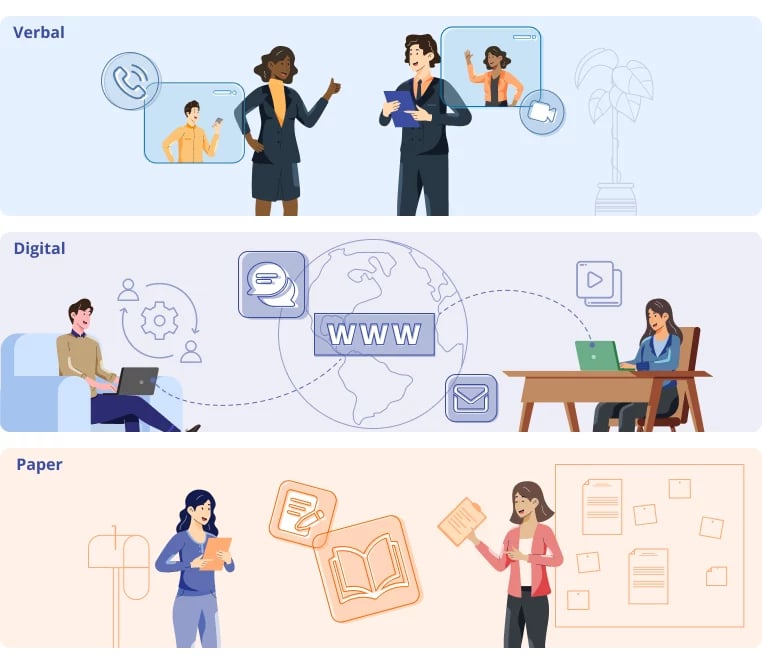
What Are the Types of Internal Communication?
For small startups with ten or so employees, a daily standup or a pulse meeting each week is probably sufficient to keep the team aligned.
However, as a company grows and develops different departments, a single company-wide meeting isn't enough to ensure all employees feel heard and are aligned on specific projects.
So to ensure all of your employees are aligned, here are the main types of internal communication:
- Top-Down Communication: Executives use this communication style to share company information, news, goals, and initiatives with the rest of the workforce. It can also be used by department heads and managers to share similar information on a department level.
- Bottom-Up Communication: This communication style is used to gather employee feedback (with pulse surveys, polls, etc.), measure alignment, and ensure that the top-down communication strategy is effective. It's also a great way to keep a pulse on company culture and ensure the organization has a positive work environment.
- Peer-to-Peer Communication: This is the two-way communication style that occurs daily between co-workers collaborating on company projects.
- Crisis Communication: In case of an emergency, each company should have a crisis communication plan that details how employees should respond.
What is An Effective Internal Communication Strategy?
Below we’ll outline how you can build an effective internal communication plan for mid to large organizations.
Step 1: Define Communication Goals
First, identify what you want to achieve with your new communication plan.
For most companies, it's probably something along the lines of:
- Improving brand vision alignment
- Shortening project timelines
- Improving product/service quality
Once you have some general goals, make them more specific and assign metrics to measure your success.
For example, if you want to shorten a project timeline, define what the timeline would look like. Then add milestones so that, in the event you don't achieve the goal, it's easy to identify where communication fell apart.

Step 2: Sketch Out Your Communication Workflow
Earlier, we discussed the various types of internal communication types, so in this step, define how each of those types of internal communication will occur.
Here's a sample communication template you can use to get started:
Top-Down Communication
- Weekly Zoom meeting (to include both live and remote workers) led by the CEO to remind everyone of the company's general vision and provide updates on key company news
- Weekly Zoom meetings in each department to discuss more specific projects and how they align with the company's broader vision
- Daily standup meetings for teams to share their goals for the day, what they accomplished the day before, and any roadblocks or challenges
- An internal comms tool to report on company news and keep employees up-to-date
Bottom-Up Communication
- Monthly or quarterly pulse survey to understand how well employees are aligned on the brand vision
- Monthly or weekly communication (call, chat, etc.) with department heads to discuss specific project alignment and progress
Peer-to-Peer Communication
- The daily standup meeting can also be used for peer-to-peer alignment
- Project management tools to provide project status updates and add quick project notes
- Instant messaging and chat (with Slack or Microsoft Team) for issues as they arise
Crisis Communication
- A documented strategy in a Google Doc that outlines what to do in various emergency scenarios
Step 3: Invest in Communication Tools to Support Your Workflow
The point of an effective communication strategy is to reduce the time it takes to transfer knowledge from one employee to another. So if you're still using legacy systems like email as the primary communication tool, your communication strategy is already at a disadvantage.
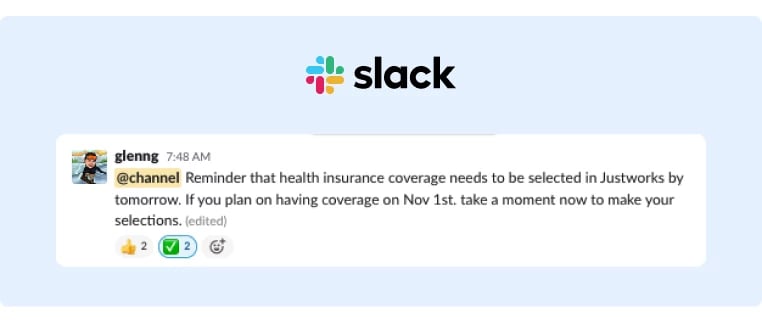
So instead, start using communication tools that aid instant communication. This means the tools you use should offer notifications and real-time updates. Depending on the communication format, these tools should also make it easy for the receiving employee to collaborate and respond with ease.
We'll discuss exact communication tools in more detail below, but here are just a few of our favorites:
- GaggleAMP – Employee Advocacy
- Slack – Chat
- Monday – Project Management
- Zoom – Synchronous Video
- Loom – Asynchronous Video
Step 4: Communicate the New Internal Comms Strategy to Employees
The best corporate communication strategy in the world won't be helpful if your frontline employees don't adopt it.
So this step is communicating the new internal comms strategy to your employees. Given that it will require some effort for employees to change, you'll probably have to sell its value to employees to get them to adopt it.
To help you craft your pitch, consider using this template:
- Outline why the current communication strategy isn't working/how it could be improved
- Highlight the benefits of changing those inefficiencies (both for the company's success and how it will save them from doing revisions)
- Introduce the new communication strategy
- Finish by highlighting the benefits again
To incorporate the new strategy, use the top-down method by first discussing it with departments and then allow department heads to meet with their teams to introduce the strategy.
Step 5: Measure Employee Engagement and Identify Improvement Opportunities
Once you've had some time to test the new and improved internal communication strategy, assess it by looking at it from a results-first perspective.
So start by looking at:
- Negative customer reviews
- Missed deadlines
- Missed growth metrics
From there, you can look at the problematic projects and identify where production lagged and misalignment cropped up. This makes it easy to work backward to analyze communication inefficiencies that caused the problems.
You can also survey employees to get a 30,000 foot view of how well your internal communication strategy is supporting employee satisfaction and the brand's vision alignment.
What Are the Best Internal Communication Tools?
Here are just a few of our favorite internal communication software solutions.
GaggleAMP – Employee Advocacy
GaggleAMP is an employee advocacy tool that makes both internal and external communication super easy.
First, it offers a forum called Community, where employees can communicate with each other and discuss current company news. This transparency helps improve company alignment, improve employee relationships and create a more connected culture.
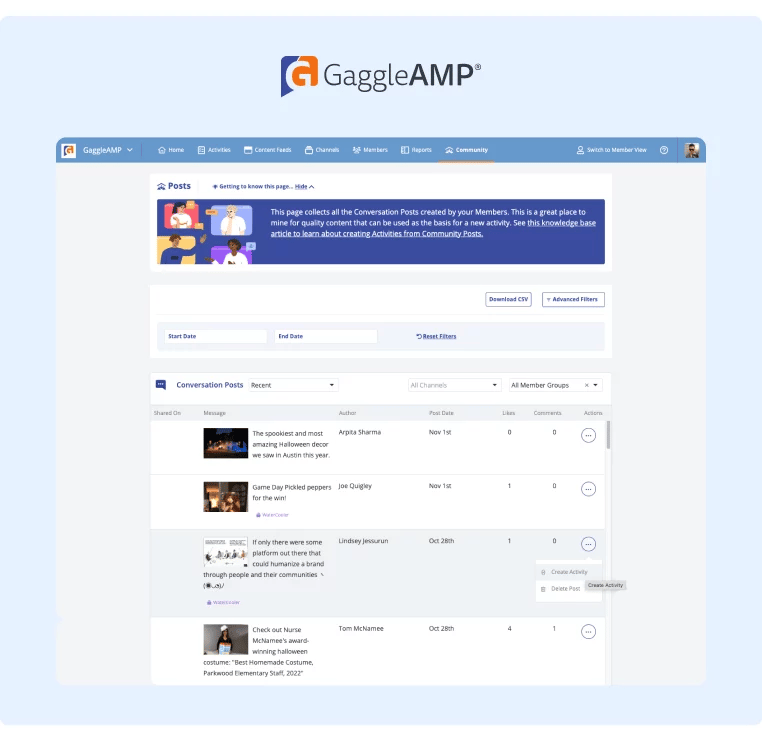
External employee advocacy is also useful for improving employee engagement as it helps employees stay up-to-date with current company news. So within GaggleAMP, managers can assign specific posts to employees to amplify brand initiatives and social reach.
After an engagement activity is assigned, employees receive a notification that they have a new activity to perform. They can then log into the Gaggle, complete the activities, and schedule them to publish at a future date/time.

When employees complete these activities, GaggleAMP awards them points and then ranks employees by engagement in the public leaderboard.
This creates friendly competition, which further encourages engagement and participation. As an added benefit, it also allows managers to reward brand advocacy efforts to make employees feel appreciated.
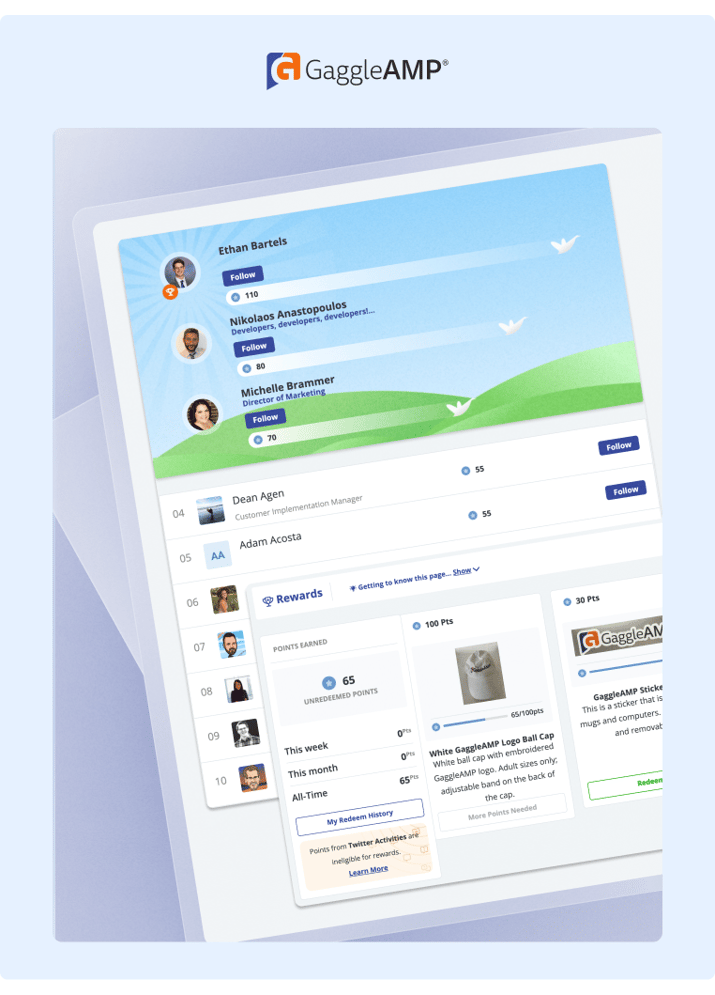
To see for yourself if GaggleAMP is a good fit for your internal communication strategy, schedule a demo or try it out free today!
Slack – Chat
Slack is one of the most well-known internal communication tools available, and it's excellent for basic day-to-day communication.
You can create separate channels for different departments or projects yet still chat privately for one-on-one conversations.
It's also easy to send files, documents, media, and more inside the chat, and it integrates easily with various file-sharing tools.
It's available on both desktop and mobile, and while the default mode sends notifications immediately, users can customize them to their work schedule.
Monday – Project Management
Monday is another essential communication platform that makes project management super easy and is suitable for large and small businesses.
You can easily create a project, add members to it, set milestones, and update project status. This makes it easy for the entire team to stay aligned with project progress without getting on a call or sending a message.
It also has one of the most user-friendly interfaces, which makes it super easy for employees to get the hang of and feel comfortable using.
From the manager's perspective, a key benefit of Monday is that it's easy to view company progress from a 30,000 foot view and quickly understand how the entire department is doing on their goals.
Like the other products on this list, Monday also allows users to turn on notifications for critical project updates to avoid missing important messages.
We’re big Monday users here at GaggleAMP and manage most of our project-related items on Monday. 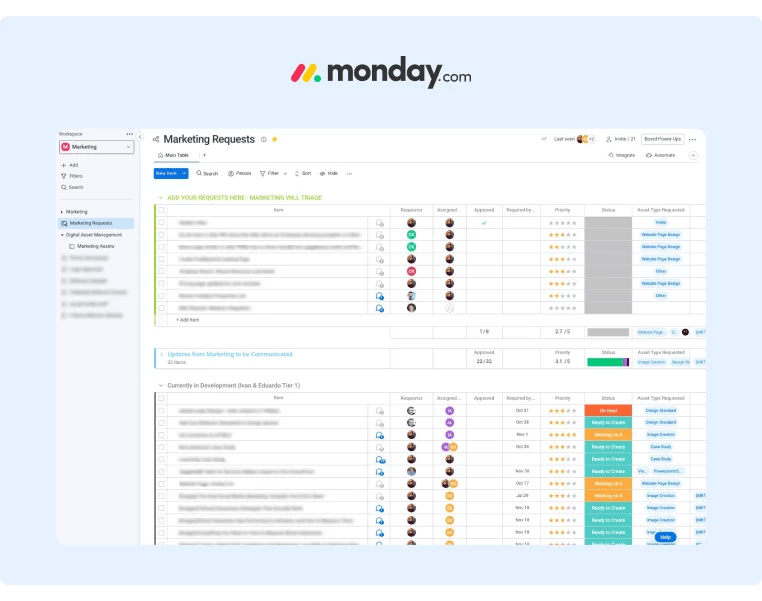
Zoom – Synchronous Video
If you need to communicate verbally, Zoom is still one of the leading communication platforms for video engagement.
The key benefits of Zoom are that it enables users to:
- Record video calls for free (up to 40 minutes)
- Choose to make it a video or voice call
- Change the background/screen
As an industry leader, Zoom integrates with most other tools, and it's pretty easy to use.
Another benefit of choosing a popular tool like Zoom is that if you run into technical issues, there are plenty of troubleshooting resources to help.
Loom – Asynchronous Video
A key communication best practice is shortening the lag between when a problem is communicated and answered.
If the topic is too complex to be written out and needs to be explained verbally, a great solution is using an asynchronous video tool like Loom.
Loom lets you record your face with your screen (or just your screen/face) and records audio. This makes it a great tool to replace live video calls that can be difficult/annoying to schedule and attend.
Loom also offers a browser extension that makes it easy to record a video on any tab. After recording the video, just grab the link and send it to your teammate rather than downloading a file.
Loom also notifies you when someone has viewed your video, which makes it easy to track engagement.
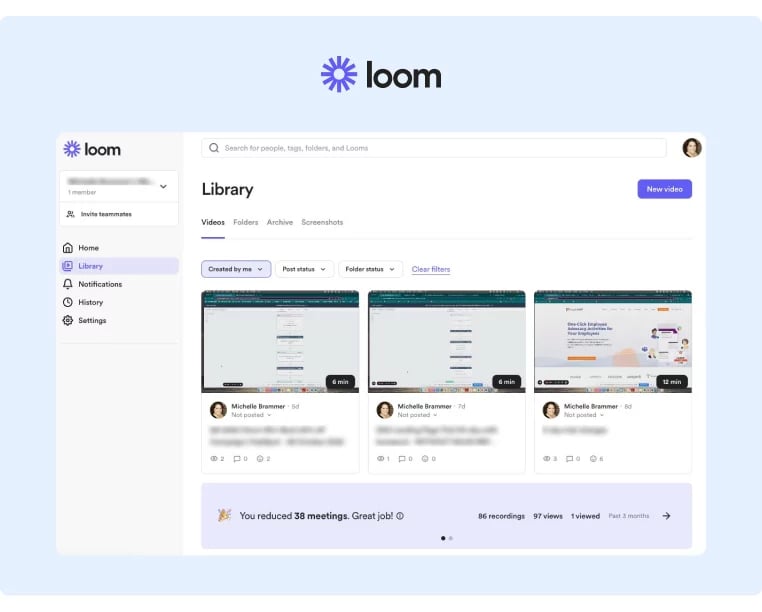
Improve Your Internal Communication Today
A company’s internal communication strategy is the lifeblood of its operations and therefore significantly impacts deadlines, project quality, customer service, and more.
While establishing systems and processes is critical to effective internal communication, providing your team with software to automate communication is equally important.
If you’re looking for a simple platform that makes internal communication seamless and encourages employee engagement, schedule a demo of GaggleAMP today!








